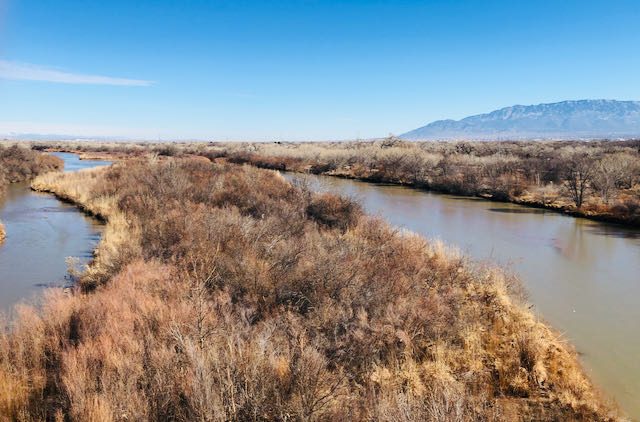
Rio Grande in Albuquerque, looking north from the Gail Ryba Bridge, Feb. 20, 2021
We stopped on Saturday’s bike ride for one of my favorite views of the Rio Grande, looking north from the Gail Ryba Bridge (the bike bridge that parallels Interstate 40). The Rio Grande looks great right now, but looks can be deceiving.
This time of year there’s always “base flow” – the basic winter flow in the river, before the snowmelt season starts. But while it looks like a healthy flow, it’s not. Normal flow this time of year is 800 cubic feet per second. Right now it’s around 500 cubic feet per second. That’s still enough to fill the river bank to bank, so it looks fine, but it’s a lot less than it should be in mid-February, around the 10th percentile.
That’s now. What to expect come spring?
First, the snowpack
This is the place where we’re really seeing climate change bite, now. As my friend Dave Gutzler, UNM’s climate science guy, pointed out in a Zoom call a couple of weeks ago with a group of climate adaptation people, the snowpack isn’t all that bad, but for a given amount of snow, we’re seeing a lot less water in the river over the last few decades. So the snowmelt runoff forecast, flows into the Albuquerque reach of the valley from March through July when we usually see the highest flows, are forecast to be 59 percent of the long term average.
Second, the upstream reservoir storage
It’s basically empty. We used it all up last year, with very little carryover storage. So our usual trick for propping up the river during a dry year like this – store water in wet years to use in years like this – isn’t available. In the last few similar years (2020 and 2018), it was use of this storage water that kept the river from going dry through Albuquerque.
Our irrigation district has postponed its season from the usual March 1 start to April 1. I’m not sure, but I believe this is something they’ve never done. They’ve also warned farmers of very short supplies, and told them that if they can, don’t plant. They’ve never done that before either.
Best case scenario
We get a some good storms through May, and/or farmers fallow enough land to keep some water in the river through Albuquerque.
Worst case scenario
The river goes dry or nearly through Albuquerque for the first time since the 1980s.

Must be Federal projects, paybacks are ongoing regardless. I’d bet they plant >50%, prevented planting option can be iffy if prices are good. The ones with back up wells will pump the darns out of the aquifer. More streambed loss and miff TX. One can’t keep up with taxes and debt if a crop isn’t raised Greg
A question of real interest, is what happens if this continues? There is a point when farms will stop using river water, and start pumping groundwater again. What happens after than?
When you combine global climate change, and the natural variability of rainfall, we will get to a point where there isn’t water for somebody. When and how often will that include cities? (The Colorado River is in year 20+ of a regional mega-drought. The current mega-drought, on top of the existing over-allocation of the river and continuing climate change, means we could face as much as a 40% reduction in flow by mid-century,)
It’s time we started to say that the rivers can’t support the population that people in power are trying to create. Right now, the problem is controlled by forcing current users to have less water, so the local governments can give the savings to more people, at a subsidized price.